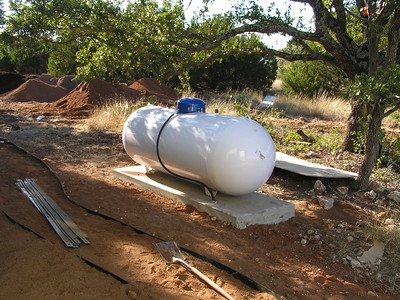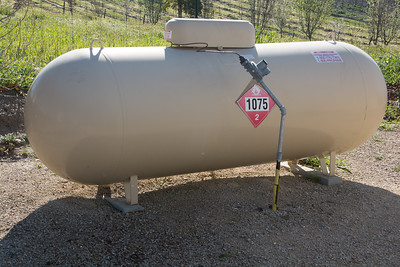
When it comes to choosing a propane tank, deciding between a 500-gallon or a 1000-gallon tank can feel a bit overwhelming. Both sizes have their pros and cons, and the right choice really depends on your specific needs.
In this article, we’ll break down the differences between the two tank sizes and help you figure out which one is the best fit for your home. Whether you’re heating your house, cooking, or running other appliances, we’ll guide you through the key factors to consider so you can make the best decision.
Understanding the Differences Between 500 and 1000-Gallon Propane Tanks
Size and Capacity:
- Physical Size Difference:
- A 500-gallon tank measures around 10 feet long and 3.5 feet in diameter. This size is more compact, making it easier to fit into smaller spaces. If you have a smaller yard or limited space near your home, this tank might be more convenient.
- A 1000-gallon tank, on the other hand, is much larger at around 16 feet long and 4 feet in diameter. This size requires more space, so you’ll need to ensure you have a big enough area to accommodate it. The larger size might also be more noticeable in your yard, so consider the visual impact if aesthetics are important to you.
- Propane Capacity:
- A 500-gallon tank holds about 400 gallons of propane when full (tanks are typically filled to 80% of their capacity for safety reasons, leaving room for the gas to expand). This amount of propane is generally sufficient for households with moderate propane usage, such as heating a small home or running a few appliances.
- A 1000-gallon tank can hold approximately 800 gallons of propane, also filled to 80% capacity. This larger capacity means you can store more propane at once, which is beneficial if you use propane for multiple applications or if you want to minimize the number of refills you need throughout the year.
Common Uses for Each Size:
- 500-Gallon Tank:
- This tank size is ideal for smaller homes or for those who use propane for basic needs. For example, if you only use propane for heating your home, cooking, and hot water, a 500-gallon tank might be sufficient. It’s also a good option if you live in a milder climate where you don’t need to use as much propane to keep your home warm.
- Another scenario where a 500-gallon tank works well is if you have limited propane use throughout the year. For instance, if you only use propane for a couple of appliances or if you’re only at your home part-time, this smaller tank might be all you need.
- 1000-Gallon Tank:
- A 1000-gallon tank is better suited for larger homes or for those who have heavy propane usage. If you use propane for multiple purposes, such as heating a large home, cooking, heating water, running a generator, or even heating a pool, the larger capacity of a 1000-gallon tank can meet these demands.
- This tank size is also a great choice if you live in a colder climate where you rely on propane to keep your home warm during the winter months. The larger capacity means you won’t have to worry about running out of propane as quickly, and you can avoid more frequent refills, which can be especially useful during harsh weather conditions when deliveries might be less predictable.
Factors to Consider When Choosing the Right Size
Household Size and Usage:
- How the Number of People in Your Home Affects Propane Usage:
- The more people living in your home, the more propane you’ll likely need. For example, a larger family will use more hot water for showers, laundry, and dishwashing, which can increase propane consumption. If you have a household with only one or two people, a 500-gallon tank might be sufficient. However, if you have a larger family or frequently have guests, you might need the extra capacity of a 1000-gallon tank to avoid running low on propane.
- Different Appliances That May Require Propane and How They Impact Your Choice:
- Consider which appliances in your home run on propane. Common ones include heating systems, water heaters, stoves, ovens, clothes dryers, and fireplaces. If you have several of these propane-powered appliances, your propane needs will be higher. Additionally, if you have less common propane uses like a pool heater or backup generator, you may want to lean towards a larger tank, like a 1000-gallon one, to ensure you have enough propane to meet all your needs.
Climate and Location:
- How Living in a Colder Climate Might Require a Larger Tank:
- If you live in a region with cold winters, you’ll likely use more propane to heat your home. A 500-gallon tank might not be enough to last through the winter without multiple refills, which could be inconvenient and potentially more expensive. In colder climates, a 1000-gallon tank allows you to store more propane, providing peace of mind that you’ll have enough fuel to keep your home warm during extended cold spells.
- The Importance of Having a Larger Tank If Your Home Is Far From Propane Refilling Stations:
- If you live in a remote location or far from propane suppliers, a larger tank can be a practical choice. Having a 1000-gallon tank means you’ll need fewer deliveries, reducing the hassle of scheduling refills and ensuring you don’t run out of propane during times when getting a delivery might be difficult. This is especially important in rural areas or places where weather conditions could delay propane delivery.
Cost Implications
Initial Cost:
- Price Comparison Between a 500-Gallon and a 1000-Gallon Tank:
- When you first purchase a propane tank, the cost of a 500-gallon tank is generally lower than a 1000-gallon tank. On average, a new 500-gallon tank might cost between $1,200 and $1,800, depending on the brand, installation requirements, and location. In contrast, a 1000-gallon tank usually costs between $2,000 and $3,500. The higher price for the larger tank reflects its increased capacity and the extra materials needed to manufacture and install it.
- Additionally, installation costs can vary depending on the complexity of the job. For example, installing a 1000-gallon tank might require more site preparation and labor, which can add to the overall cost.
Long-Term Savings:
- How a Larger Tank Might Save Money in the Long Run Due to Fewer Deliveries:
- Although a 1000-gallon tank has a higher upfront cost, it can save you money over time by reducing the frequency of deliveries. Since a 1000-gallon tank holds twice as much propane as a 500-gallon tank, you’ll need refills less often. This can save on delivery fees, which some propane companies charge for each trip.
- Fewer deliveries also mean less hassle, especially during peak usage times like winter, when propane demand is high and delivery schedules can be tight.
- Potential Bulk Purchasing Discounts When Filling a Larger Tank:
- Another advantage of a 1000-gallon tank is the potential for bulk purchasing discounts. Propane suppliers often offer lower per-gallon prices if you buy in larger quantities. Since a 1000-gallon tank allows you to purchase more propane at once, you may qualify for these discounts, reducing your overall fuel cost. This can lead to significant savings, especially if you fill your tank when propane prices are lower during off-peak seasons.
Space and Installation Requirements
Space Availability:
- How Much Space Each Tank Size Requires in Your Yard:
- A 500-gallon tank is about 10 feet long and 3.5 feet in diameter, so it takes up a moderate amount of space in your yard. This size is typically easier to fit in smaller yards or closer to your home without being too intrusive.
- A 1000-gallon tank is much larger, measuring around 16 feet long and 4 feet in diameter. This means you’ll need a larger area in your yard to accommodate it. If you have a bigger property or plenty of open space, this may not be an issue. However, in smaller yards or tight spaces, finding a suitable spot for a 1000-gallon tank can be challenging.
- Consideration of Local Regulations on Tank Placement:
- When deciding where to place your propane tank, you’ll need to consider local regulations and codes. For example, most areas require that propane tanks be placed a certain distance from your home, property lines, and other structures. Typically, a 500-gallon tank must be at least 10 feet away from any buildings or property lines, while a 1000-gallon tank may require even more space, sometimes up to 25 feet.
- Additionally, underground installations, if allowed, may have different regulations that require specific safety measures, which could impact your decision on tank size and placement.
Installation Costs:
- Discussion of the Installation Process for Both Tank Sizes:
- The installation process for both a 500-gallon and 1000-gallon tank involves similar steps, but a larger tank might require more time and effort. Both sizes will need a stable, level surface for installation, and depending on your location, you might need to pour a concrete pad or create a gravel bed to support the tank. If you’re opting for an underground tank, excavation will be necessary, which adds to the complexity.
- A 500-gallon tank is generally easier and quicker to install, especially if you’re placing it above ground. A 1000-gallon tank may require more labor and equipment, particularly if it’s being buried, which can increase installation time and costs.
- Potential Additional Costs for Site Preparation and Installation:
- Site preparation costs can vary based on the condition of your yard and the specific requirements for tank placement. For instance, if your yard needs significant leveling, clearing, or other modifications, this could increase the cost of installation.
- Additionally, if you’re installing a 1000-gallon tank, you may need to invest in more substantial site preparation, such as a larger concrete pad or more extensive excavation if it’s going underground.
- In some cases, you might also need to factor in the cost of permits, inspections, or hiring specialized contractors to handle specific aspects of the installation, such as electrical work if the tank is connected to a generator.
Safety Considerations
Safety Features:
- Overview of Safety Features Common to Both Tank Sizes:
- Whether you choose a 500-gallon or 1000-gallon propane tank, both are equipped with essential safety features designed to protect your home and property. These include pressure relief valves that release propane if the pressure inside the tank becomes too high, which helps prevent accidents. Both tank sizes also have shut-off valves that allow you to quickly stop the flow of propane in case of an emergency.
- Additionally, overfill protection devices (OPD) ensure that the tank is not filled beyond its safe capacity, and excess flow valves automatically limit the flow of propane if a line or hose is damaged. These safety features are standard for both tank sizes, ensuring that your propane system operates safely regardless of the tank size you choose.
Regulatory Compliance:
- Brief Mention of Any Regulations You Need to Follow When Installing Either Tank Size:
- When installing a propane tank, there are specific regulations and codes that you must follow to ensure safety and compliance. These regulations vary by location but generally include rules about how far the tank must be from your home, property lines, and other structures. For example, a 500-gallon tank is usually required to be at least 10 feet from any buildings, while a 1000-gallon tank might need to be placed 25 feet away.
- Additionally, local fire codes may dictate where and how the tank can be installed, and you may need to obtain permits before installation. Ensuring compliance with these regulations is crucial to avoid penalties and ensure the safety of your property.
Importance of Professional Installation and Regular Maintenance:
- Why Professional Installation Is Crucial:
- Installing a propane tank is not a DIY project. Professional installation ensures that the tank is set up correctly and safely, reducing the risk of leaks, fires, or other hazards. A licensed technician will handle all aspects of the installation, including connecting the tank to your propane system, performing pressure tests, and ensuring that all safety features are functioning properly.
- Regular Maintenance for Safety:
- After installation, regular maintenance is essential to keep your propane system safe and efficient. This includes routine inspections of the tank, valves, and connections, as well as checking for any signs of wear or damage. Regular maintenance can help prevent issues like leaks or pressure problems, ensuring that your propane system continues to operate safely over time. It’s also a good idea to schedule an annual inspection by a professional to catch any potential problems before they become serious.
Making the Decision: Which Size is Right for You?
Weighing the Pros and Cons:
- 500-Gallon Tank:
- Pros:
- Lower initial cost.
- Requires less space, making it ideal for smaller yards.
- Sufficient for households with moderate propane usage or fewer appliances that rely on propane.
- Easier and less costly to install.
- Cons:
- Smaller capacity, which means more frequent refills, especially in colder climates or during peak usage periods.
- May not be sufficient for larger homes or households with high propane demands.
- Pros:
- 1000-Gallon Tank:
- Pros:
- Larger capacity means fewer refills, which can save money on delivery fees and offer convenience.
- Ideal for larger homes or those with heavy propane usage, such as heating, cooking, and running multiple propane-powered appliances.
- Potential for bulk purchasing discounts, reducing overall propane costs.
- Cons:
- Higher initial cost and more expensive installation.
- Requires more space, which can be challenging in smaller yards.
- Larger visual impact in your yard and potentially stricter local regulations.
- Pros:
Encourage readers to consider their specific needs when choosing a tank size. If you have a smaller household, use propane sparingly, or have limited space, the 500-gallon tank might be the better option. On the other hand, if you have a larger home, use propane for multiple purposes, or want the convenience of fewer refills, the 1000-gallon tank could be a smarter choice.
Final Recommendation:
When deciding between a 500-gallon and 1000-gallon propane tank, it’s essential to evaluate your current and future propane needs, space availability, and budget. Think about how much propane you typically use, the climate you live in, and how often you want to deal with refills.
If you’re still unsure, consulting a propane professional can be incredibly helpful. They can assess your home, discuss your usage patterns, and provide personalized advice on which tank size will work best for you. A professional can also guide you through any local regulations and help ensure that your tank is installed safely and correctly.
Weighing the Pros and Cons:
- 500-Gallon Tank:
- Pros:
- Lower initial cost.
- Requires less space, making it ideal for smaller yards.
- Sufficient for households with moderate propane usage or fewer appliances that rely on propane.
- Easier and less costly to install.
- Cons:
- Smaller capacity, which means more frequent refills, especially in colder climates or during peak usage periods.
- May not be sufficient for larger homes or households with high propane demands.
- Pros:
- 1000-Gallon Tank:
- Pros:
- Larger capacity means fewer refills, which can save money on delivery fees and offer convenience.
- Ideal for larger homes or those with heavy propane usage, such as heating, cooking, and running multiple propane-powered appliances.
- Potential for bulk purchasing discounts, reducing overall propane costs.
- Cons:
- Higher initial cost and more expensive installation.
- Requires more space, which can be challenging in smaller yards.
- Larger visual impact in your yard and potentially stricter local regulations.
- Pros:
Encourage readers to consider their specific needs when choosing a tank size. If you have a smaller household, use propane sparingly, or have limited space, the 500-gallon tank might be the better option. On the other hand, if you have a larger home, use propane for multiple purposes, or want the convenience of fewer refills, the 1000-gallon tank could be a smarter choice.
Final Recommendation:
When deciding between a 500-gallon and 1000-gallon propane tank, it’s essential to evaluate your current and future propane needs, space availability, and budget. Think about how much propane you typically use, the climate you live in, and how often you want to deal with refills.
If you’re still unsure, consulting a propane professional can be incredibly helpful. They can assess your home, discuss your usage patterns, and provide personalized advice on which tank size will work best for you. A professional can also guide you through any local regulations and help ensure that your tank is installed safely and correctly.
Image source: S (Flickr)

Mike is an experienced propane technician with over 15 years of professional experience in the field. He has dedicated his career to helping customers with their propane needs, from installation to maintenance and repair. Together with Jeremy, he co-founded this website to provide useful information and guidance to customers seeking reliable propane services.




